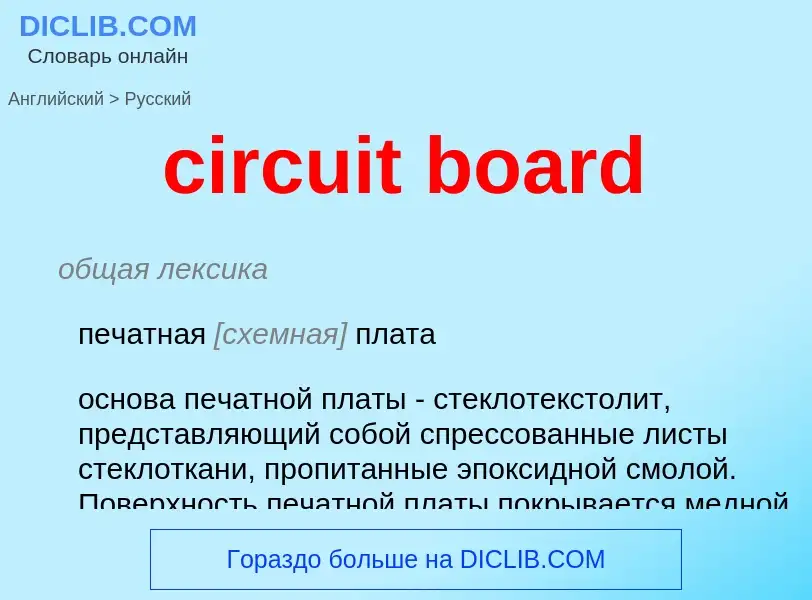Translation and analysis of words by ChatGPT artificial intelligence
On this page you can get a detailed analysis of a word or phrase, produced by the best artificial intelligence technology to date:
- how the word is used
- frequency of use
- it is used more often in oral or written speech
- word translation options
- usage examples (several phrases with translation)
- etymology
circuit board - translation to russian
общая лексика
печатная [схемная] плата
основа печатной платы - стеклотекстолит, представляющий собой спрессованные листы стеклоткани, пропитанные эпоксидной смолой. Поверхность печатной платы покрывается медной фольгой, из которой с помощью фотошаблонов и химического травления получают сигнальный слой с проводниками, соединяющими контактные площадки для микросхем. Печатные платы могут состоять из нескольких сигнальных слоёв: плата с одним слоем называется односторонней, с двумя - двусторонней, с четырьмя и более - многослойной. Связь между слоями осуществляется, как правило, с помощью металлизированных отверстий. Питание и масса (земля) в целях защиты от электромагнитных наводок между линиями обычно выносятся на отдельные слои
Definition
Wikipedia

A printed circuit board (PCB; also printed wiring board or PWB) is a medium used in electrical and electronic engineering to connect electronic components to one another in a controlled manner. It takes the form of a laminated sandwich structure of conductive and insulating layers: each of the conductive layers is designed with an artwork pattern of traces, planes and other features (similar to wires on a flat surface) etched from one or more sheet layers of copper laminated onto and/or between sheet layers of a non-conductive substrate. Electrical components may be fixed to conductive pads on the outer layers in the shape designed to accept the component's terminals, generally by means of soldering, to both electrically connect and mechanically fasten them to it. Another manufacturing process adds vias: plated-through holes that allow interconnections between layers.
Printed circuit boards are used in nearly all electronic products. Alternatives to PCBs include wire wrap and point-to-point construction, both once popular but now rarely used. PCBs require additional design effort to lay out the circuit, but manufacturing and assembly can be automated. Electronic design automation software is available to do much of the work of layout. Mass-producing circuits with PCBs is cheaper and faster than with other wiring methods, as components are mounted and wired in one operation. Large numbers of PCBs can be fabricated at the same time, and the layout has to be done only once. PCBs can also be made manually in small quantities, with reduced benefits.
PCBs can be single-sided (one copper layer), double-sided (two copper layers on both sides of one substrate layer), or multi-layer (outer and inner layers of copper, alternating with layers of substrate). Multi-layer PCBs allow for much higher component density, because circuit traces on the inner layers would otherwise take up surface space between components. The rise in popularity of multilayer PCBs with more than two, and especially with more than four, copper planes was concurrent with the adoption of surface mount technology. However, multilayer PCBs make repair, analysis, and field modification of circuits much more difficult and usually impractical.
The world market for bare PCBs exceeded $60.2 billion in 2014 and is estimated to reach $79 billion by 2024.


![via]], visible as a bright copper-colored band running between the top and bottom layers of the board. via]], visible as a bright copper-colored band running between the top and bottom layers of the board.](https://commons.wikimedia.org/wiki/Special:FilePath/Bga und via IMGP4531 wp.jpg?width=200)



![Cordwood construction was used in [[proximity fuze]]s. Cordwood construction was used in [[proximity fuze]]s.](https://commons.wikimedia.org/wiki/Special:FilePath/MK53 fuze.jpg?width=200)


![vias]] (the through-hole paths to the other surface), and some electronic components mounted using through-hole mounting vias]] (the through-hole paths to the other surface), and some electronic components mounted using through-hole mounting](https://commons.wikimedia.org/wiki/Special:FilePath/PCB Spectrum.jpg?width=200)


